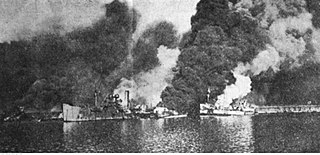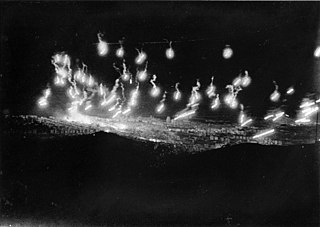
Foggia is a city and former comune of Apulia, in Southern Italy, capital of the province of Foggia. In 2013, its population was 153,143. Foggia is the main city of a plain called Tavoliere, also known as the "granary of Italy".
An airraid of USAAF planes against Frascati, a historic town near Rome, Italy, was made on 8 September 1943. The target was the German General Headquarters for the Mediterranean zone (O.B.S.) and the Italian headquarters, scattered in buildings and villas near the town.

During World War II the Italian city of Naples suffered approximately 200 air raids by the Allies from 1940 to 1944; only Milan was attacked more frequently. Almost all of the attacks — a total of 181 — were launched in the first nine months of 1943 before the Four days of Naples and the Allied occupation of the city at the beginning of October. Estimates of civilian casualties vary between 20,000 and 25,000 killed.

The bombing of Rome in World War II took place on several occasions in 1943 and 1944, primarily by Allied and to a smaller degree by Axis aircraft, before the city was liberated by the Allies on June 4, 1944. Pope Pius XII was initially unsuccessful in attempting to have Rome declared an open city, through negotiations with U.S. President Franklin D. Roosevelt via Archbishop Francis Spellman. Rome was eventually declared an open city on August 14, 1943 by the defending Italian forces.

The air raid on Bari was an air attack by German bombers on Allied forces and shipping in Bari, Italy, on 2 December 1943, during World War II. 105 German Junkers Ju 88 bombers of Luftflotte 2 achieved surprise and bombed shipping and personnel operating in support of the Allied Italian Campaign, sinking 27 cargo and transport ships, as well as a schooner, in Bari harbour.
This is a timeline of events that occurred during World War II in 1943.

The Four Days of Naples was an uprising in Naples, Italy, against Nazi German occupation forces from September 27 to September 30, 1943, immediately prior to the arrival of Allied forces in Naples on October 1 during World War II.
Nicola Bellomo was a general in the Italian Army during World War II. He was tried for war crimes at a court-martial for the murder of a British prisoner of war. He was found guilty. He was one of the few Italian commissioned officers prosecuted for war crimes during World War II, and the only one to be executed by a British-controlled court.

Rimini railway station is the main station serving the city and comune of Rimini, in the region of Emilia-Romagna, northern Italy. Opened in 1861, it forms part of the Bologna–Ancona railway, and is also a terminus of a secondary railway linking Rimini with Ravenna and Modena.
The Allied bombing of Yugoslavia in World War II involved air attacks on cities and towns in the Kingdom of Yugoslavia by the United States Army Air Force (USAAF) and Royal Air Force (RAF), including the Balkan Air Force (BAF), between 1941 and 1945, during which period the entire country was occupied by the Axis powers. Dozens of Yugoslav cities and towns were bombed, many repeatedly. These attacks included intensive air support for Yugoslav Partisan operations in May–June 1944, and a bombing campaign against transport infrastructure in September 1944 as the German Wehrmacht withdrew from Greece and Yugoslavia. This latter operation was known as Operation Ratweek. Some of the attacks caused significant civilian casualties.

The bombing of Pescara was a series of attacks by the United States Army Air Force on the city of Pescara in Abruzzo, Italy during World War II. The raids caused thousands of civilian casualties and left 80 % of the city destroyed or damaged.

The bombing of Ancona was a series of attacks by the United States Air Force on the city of Ancona in the Marche, Italy during World War II. The raids caused heavy civilian casualties and destroyed or damaged nearly 70 % of the city.

The bombing of Pisa took place on 31 August 1943, during World War II. Aimed at disabling the city's marshalling yard, it also resulted in heavy damage to the city itself and civilian casualties.

The bombing of Cagliari was a series of attacks by the United States Army Air Force and the Royal Air Force on the Italian city of Cagliari, the regional capital of Sardinia, during World War II. The raids, aimed at destroying the port facilities and airfields of Cagliari, also resulted in the destruction of most of the city.

Owing to its importance as an industrial center, home to Fiat and several other industries engaged in war production, Turin, the regional capital of Piedmont, suffered over a hundred raids by the Allied air forces during World War II; the Piedmontese capital was thus among the most bombed cities in Northern Italy, suffering damage to about 40% of its housing stock, and over 2,000 victims among its population.

During World War II the Italian city of Palermo, the regional capital and largest city of Sicily, was heavily bombed by both the Royal Air Force and the United States Army Air Force.

During World War II the Italian city of Bologna, the regional capital and largest city of Emilia-Romagna, suffered nearly a hundred air raids by the Royal Air Force and the USAAF, mostly aimed at disabling its strategically important marshalling yards, used for the movements of German troops and supplies between Northeastern Italy and central Italy. These raids destroyed or damaged almost half of the city, and caused nearly 2,500 victims among its population.

During World War II, Tuscany, the Italian port city of Livorno was repeatedly bombed by the Allied air forces, suffering about a hundred raids altogether, which resulted in it being among the most war-damaged cities in Italy.

Owing to the importance of its port and industries, the Italian port city of Genoa, the regional capital and largest city of Liguria, was heavily bombarded by both Allied air and naval forces during Second World War, suffering heavy damage.

The bombing of Reggio Calabria was a series of attacks by the United States Army Air Force and the Royal Air Force on the Italian city of Reggio Calabria during World War II. All together, Reggio Calabria suffered 24 air raids, aimed at disabling its port facilities, airfield and marshalling yards, leaving most of the city destroyed or damaged.